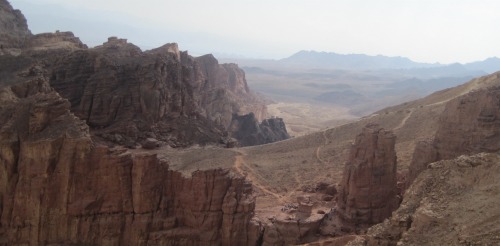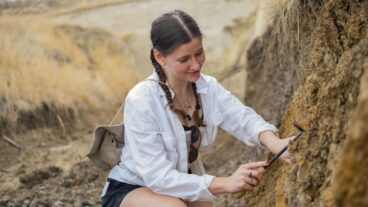Israel is a hiker’s paradise. The country is crisscrossed with trails, including the 580-mile long Israel Trail, which starts in the northern Galilee and winds its way south until it reaches the tip of Eilat. All of Israel’s trails are clearly marked by colors painted on rocks, and you can buy a set of 20 glossy maps (about $25 each) to keep you moving in the right direction.
Picking just 10 tiyulim (Hebrew for “hikes”) was tough, but here is ISRAEL21c’s top 10 list, organized by region.
Jerusalem area
Nahal Katlav (4 hours)

This lovely four-hour hike starts at the Bar Behar restaurant and ice cream stand, a short drive west from Jerusalem in the Bar Giora area (the restaurant is on the road to Nes Harim). The path descends, winding past a spring until you reach the nahal – Hebrew for a dry riverbed; in Arabic it’s wadi. The walk along the nahal takes less than an hour. While there’s no water anymore, it’s still very shady, a place of beauty and solitude close to the big city.
Eventually, the trail reaches the abandoned Bar Giora train station, a good place to stop and eat lunch as Jerusalem-Tel Aviv trains pass nearby. After the station, the trail climbs steeply, passing an abandoned Arab village, before looping back to the starting point. Nahal Katlav is popular in part because you can look forward to a frozen treat at the end, especially welcome in the hotter months.
The Burma Road (3.5 hours)

The Burma Road is steeped with history. During the War of Independence, the Jordanians blocked the main route into Jerusalem, attempting to starve the city into surrender. Under the cover of night, soldiers from the nascent State of Israel clandestinely built a bypass road, which succeeded in breaking the boycott. You can now hike this road in two parts. For both, you park your car just before the Paz gas station on Highway 38, coming from Route 1, the Jerusalem-Tel Aviv Highway. Both segments follow the Israel Trail for some of the way.
The western part of the trail goes along the Burma Road in the direction of Latrun, but you’ll be turning north before then to make a loop back to your starting point. This takes you through a pine forest known as Park Rabin. There is also a bike rental shop as the trail is popular with cyclists.
The eastern flank of the trail across the road kicks off with a very steep ascent until reaching the village of Beit Meir. Along the way are some great views of the highway far below. From the top, you can continue on the Burma Road toward Jerusalem, or descend through the Martyr’s Forest, established by B’nai B’rith to commemorate those lost in the Holocaust. There are various memorials, plaques and even a cave. The trail ends up on Highway 38, where you can catch a shared taxi and take it three stops back to your car.
Dead Sea area
Upper Nahal David (1 hour or 5 hours)

Nahal David is the most touristy part of the Ein Gedi Nature Reserve. You pay an entrance fee of about $5 (discounts for children and soldiers), then make the short 30-minute hike to David’s waterfall for pictures and snacks. More intrepid hikers can extend the hike to nearly five hours by starting at the nearby Ein Gedi Field School.
The first half hour of the hike heads up a tough mountain (including one short segment where you’re climbing straight up without any footholds). The trail then winds around until it reaches a narrow canyon that can only be traversed by hanging on rungs dug into the mountain face (think of it as hiking on monkey bars) and jumping over — or wading into — pools of water of varying depths, depending on the time of year.
The payoff at the end of the canyon (which can take anywhere from 15 to 45 minutes to traverse, depending on how nimble you are) is an opening toward the Dead Sea called the halon (“window”). There’s room here for a medium-sized group to eat lunch and admire the stunning view. You then go back out the way you came, and climb again, before descending to the lovely Ein Gedi spring and a Chalcolithic-era temple. You’ll eventually meet up with the aforementioned short hike through Nahal David. No one’s checking at the entrance, but be nice and pay the entrance fee.
Nahal Dragot
If adventure is your game, the lower part of Nahal Dragot (more popularly known by its Arabic name, Darga) will keep your heart beating. Indeed, the hike is considered somewhat of a rite of passage for Israelis.
Drive along the Dead Sea road and head up to Metzukei Dragot. The Darga is incredibly challenging, with 50-meter-high walls, dry waterfalls and pools of natural water in craters that you have to swim across. Although there are metal stakes hammered into the rocks in some places, you really can’t do this hike without a rope. Or, in some places, skip the rope and jump into the water below. Warning: Don’t do this hike alone!
If ropes aren’t your thing, there are also several tamer routes within the nahal that stick to the upper plains. The views are spectacular and you can tell your friends that you “did” the Darga.
Judean Desert
Wadi Kelt (5-6 hours)

Wadi Kelt is the Arabic name for this area and the one used most often, though it also goes by Ein Prat and Nahal Kelt. It is one of the most popular hiking spots in Israel, with the parks authorities reporting some 60,000 visitors a year. The parking lot is too small for all the cars, so expect to leave your vehicle on the narrow road that winds down to the north from the Jerusalem-Dead Sea Highway (there are clearly marked signs).
From the parking lot, you can hike west through a series of refreshing pools and picnic spots before ascending in the direction of Pisgat Ze’ev – or head east in the direction of Jericho.
The eastern side of the tiyul is the more spectacular, cutting through a deep desert gorge with plenty of water in which to swim. Even in the heat of the summer, the high canyon walls and the water make this a pleasant refuge. Wadi Kelt has gotten a bad rap over the years – four trekkers were murdered in 1995 and 1997 – but there have been no incidents in 14 years. Nevertheless, you might consider hiking on a Friday or during a Jewish holiday when there are more people on the trail.
At the end of the hike is the Greek Orthodox Monastery of St. George; the monastic community here dates back to 420 CE. If you were to continue on, you’d reach Jericho – but you can’t, as Jericho is part of the Palestinian Authority and closed to Israelis. You can double back through the nahal or take a quicker (but less scenic) road that runs along the top of the canyon.
Nahal Og (3 hours)


Nahal Og is a beautiful walk that winds through a number of white chalk canyons. It’s mostly flat and pleasant except for one part, where it descends through several near-vertical cliffs. To scale these cliffs, you must hold onto rungs drilled into the side of the mountain. Unlike the rungs in the halon section of the Upper Nahal David hike, however, which go along the cliff wall horizontally, these rungs are truly terrifying, as you can’t see where you’re ending up. So for those with less “spatial intelligence,” you might need a guide to tell you where to place your feet.
This is a one-way tiyul; park one car near the Nebi Musa antiquities spot (there’s a sign as you descend the highway from Jerusalem toward the Dead Sea) and another near the entrance to Kibbutz Almog. As an alternative, you can start at the foot of Nahal Og and climb up – more strenuous but less scary when you get to the rungs. There are no real views, but the canyon more than makes up for it.
Nahal Og actually extends farther toward the settlement of Kfar Adumim, and you can hike the entire route in about six to seven hours. As with any hike in a nahal (particularly in the Dead Sea and Judean Desert areas), if there is a chance of rain, don’t hike! There can be a flash flood at any time.
Eilat mountains
Amram’s Pillars/The Black Canyon (4+ hours)

The start of the hike is off Highway 90; there is a clearly marked turn about 15 minutes north of Eilat. You then drive on a bumpy dirt road for another 15 minutes before parking your car (it’s not a loop, so you have to use two cars and shuttle between; the whole back-and-forth process can take up to an hour, so build that into your total hiking time).
The hike itself is worth it, though. First, stop at Amram’s Pillars, two natural rock formations at the end of a short canyon. The hike then proceeds up Mount Amir to its peak, where you’ll be treated to some great views. As you descend, you’ll have two options: a mostly flat route that goes along the Israel Trail, and another, more interesting walk through a canyon filled with ancient copper mines and digging shafts.
At the end of either of the two routes, you will be close to the Black Canyon – if you’re not short on time, don’t miss it. The canyon is filled with gray and sometimes black granite rock formations, white limestone chalk, plus some narrow passageways, which are fun to climb and slide through.
Mount Zefachot
This Eilat-area tiyul is easy to find – follow the road that leads to the Egyptian border at Taba, park slightly east of the Eilat Field School and start climbing. Mount Zefachot is not an easy ascent, nor is it a particularly beautiful climb. There are some tricky ups and a few cliffs to keep it interesting. But this hike is all about the payoff, and it’s spectacular.
From the top of the mountain, you get a panoramic view of the entire Red Sea area. You can see four countries from this vantage point: Israel, of course, but also Jordan, Egypt, and the tip of Saudi Arabia. The sea remains a shimmering blue year round, and Eilat’s mild winters make this a perfect hike to break the cold of Israel’s more northern locales.
Once you’ve drunk in the view, there are several options for the descent depending on how much you want to walk. If you take the longest option (about four hours), you’ll end up near Taba; you can then take a public Egged bus or taxi back to your car.
Galilee
Nahal Amud (2-5 hours)

Nahal Amud (“pillar canyon”) is the preeminent Galilee hike. It runs from Mount Meron in the west toward the Sea of Galilee in the east. You can walk it in either direction; starting at Meron means more downhill and is generally preferred. The nahal, which parallels the Israel Trail, is gorgeous and shaded, but the highlight is the water – this nahal is not a dry creek. In the summer, the pools are crowded with campers from various youth movements. If you can make it past them, you’ll be treated to a more relaxing walk. There are a number of ancient flour mills along the path.
The best place to start is at the parking lot off Highway 89, which connects the mystical town of Safed with Acre on the coast. This is a national park, so you’ll have to pay an entry fee. You start by winding down a steep path before arriving in the nahal. After the pools, you can continue west, or bail early near Safed. There’s a trail that climbs out of the nahal toward the cemetery in Safed. Keep heading up the hill, grab a falafel on the main street to recharge your batteries, then catch a taxi back to your starting point.
The other, much shorter alternative is to double back to the parking lot. There’s an upper trail in the nahal that avoids the pools and crowds.
Golan Heights
Nahal Yehudiah (4-5 hours)
There’s probably no better hike in the heat of summer than Nahal Yehudiah, where the water is so deep, you have no choice but to swim to get to the other side. There are actually some 12 trails in this canyon off Highway 87, just northeast of the Sea of Galilee. But the one that ranks on our top 10 list is “upper” Nahal Yehudiah. The path starts by passing a deserted Syrian village that was built on top of an earlier Jewish town from the Roman-Byzantine period. You’ll pass a cattle-grazing field before heading down into the valley towards the 20-meter high Yehudiah Falls.
That’s where the fun starts. There are two cliffs to climb down, using rungs and ladders drilled into the side of the rock – one is four meters long, the second nine meters, which ends in the pool. Make sure your belongings are wrapped up in waterproof bags, or do like some of the more creative hikers who pack small inflatable boats to float their gear across! There’s another pool after that (though you can walk it if you don’t slip). When you’re done swimming, you can backtrack to the start on a dry trail at the top of the nahal.
For information in English on nature hikes in Israel, see Israel by Foot.

















